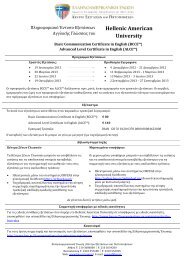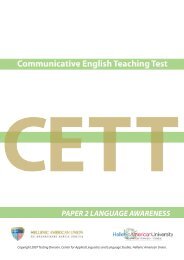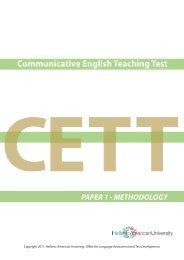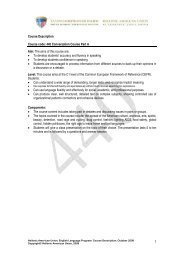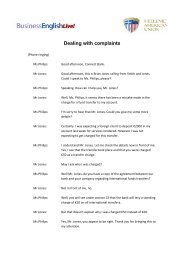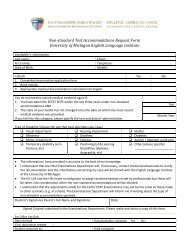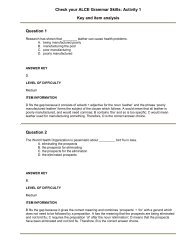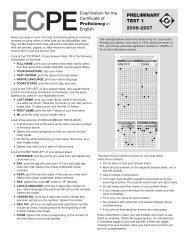ecpe teacher's guide - Hellenic American Union
ecpe teacher's guide - Hellenic American Union
ecpe teacher's guide - Hellenic American Union
Create successful ePaper yourself
Turn your PDF publications into a flip-book with our unique Google optimized e-Paper software.
<strong>ecpe</strong> teacher’s <strong>guide</strong><br />
Candidates are afforded the opportunity to demonstrate the full range of their linguistic ability.<br />
They are expected to produce spoken language that is representative of C2 level on the Common<br />
European Framework of Reference (CEFR).<br />
The semi-structured format of the ECPE Speaking Test promotes consistency in the administration of<br />
the test.<br />
Scoring<br />
A candidate’s linguistic ability is assessed independently by the two examiners and separately from<br />
the other candidate’s linguistic ability. The two examiners must then agree on a single score for each<br />
of the candidates.<br />
Candidates receive a holistic score. All stages are assessed except for the planning part for the<br />
presentation (stage 4), although even then candidates are not allowed to switch to their native<br />
language.<br />
A five-level scoring rubric A, B, C (minimum pass) and D, E (Fail) is used to assess candidate<br />
performance in three different areas:<br />
• Discourse and Interaction (development and functional range)<br />
• Linguistic resources (range and accuracy — for both vocabulary and grammar)<br />
• Delivery and Intelligibility (fluency and articulation)<br />
Please consult ECPE 2009 Speaking scoring Rubric (Condensed Version).<br />
A STEP- BY- STEP APPROACH TO THE NEW ECPE SPEAKING TEST<br />
It is very important for candidates to understand that there is no examiner involvement during<br />
candidate-to-candidate interaction. The examiner withdraws from the task and will interject only<br />
to remind candidates not to look at each other’s information sheet or to remind them of the time<br />
remaining for the stage.<br />
STAGE 1:<br />
Introductions and Small Talk (3-5 minutes)<br />
Examiner 1 Examiner 2 Candidate 1 Candidate 2<br />
• Provides brief summary<br />
of test<br />
• States purpose of stage<br />
• Initiates conversation<br />
• Establishes friendly<br />
atmosphere<br />
• Asks non-sensitive<br />
personal questions—from<br />
simple to more openended<br />
ones<br />
• Draws candidates into<br />
conversation<br />
• Provides smooth<br />
transition to next stage<br />
• Monitors candidates<br />
• Monitors the time<br />
• Sits in back of<br />
testing room until<br />
stage 4<br />
• Monitors candidates<br />
• Engages in<br />
conversation with other<br />
candidate and examiner<br />
• Answers short-response<br />
and expanded-response<br />
questions<br />
• May make comments<br />
on partner’s responses<br />
• May ask for clarification<br />
• Responds to comments<br />
• Engages in conversation<br />
with other candidate and<br />
examiner<br />
• Answers shortresponse<br />
and expandedresponse<br />
questions<br />
• May make comments<br />
on partner’s responses.<br />
May ask for clarification<br />
• Responds to comments<br />
15



